STRUCTURAL FORCES
DEMOGRAPHICS AND HUMAN DEVELOPMENT 
Key Takeaways
- Slowing population growth and a rising global median age are presenting potential economic opportunities for some developing economies, but rapidly aging and contracting populations in some developed economies and China will weigh on economic growth.
- Relatively poor countries in Sub-Saharan Africa and South Asia will account for almost all global population growth during the next two decades and will be rapidly urbanizing at the same time, most likely overwhelming their capacity to provide the infrastructure and education systems necessary to fully harness their economic growth potential.
- During the next two decades, demographic shifts and economic incentives are likely to increase pressure for migration out of developing countries, mostly from Sub-Saharan Africa, and primarily into aging, developed countries. Conflict and climate disruptions will compound these broader migration trends.
- These demographic and human development trends will put pressure on governments to increase public investment and control immigration, potentially fuel instability in some countries, contribute to a rising Asia, and add to the agenda of already strained international development institutions.

(TRENDS IN DEMOGRAPHICS 2000-2020, 2020-2040 - Click image to enlarge)
As birth rates remain low and the median age rises, most developed and many emerging economies will see their populations peak and then start to shrink by 2040.
SLOWING POPULATION GROWTH, AGING POPULATIONS
During the next 20 years, the world’s population will continue to increase every year, adding approximately 1.4 billion people to reach an estimated 9.2 billion by 2040 , but the rate of population growth will slow in all regions. Population growth in most of Asia will decline quickly, and after 2040, the population will begin to contract. Although India’s population growth is slowing, it will still overtake China as the world’s most populous country around 2027. As birthrates remain low and the median age rises, most developed and a handful of emerging economies will see their populations peak and then start to shrink by 2040, including China, Japan, Russia, and many European countries. In contrast, Sub-Saharan Africa will account for around two-thirds of global population growth and is poised to nearly double its current population by 2050, portending extensive strains on infrastructure, education, and healthcare.
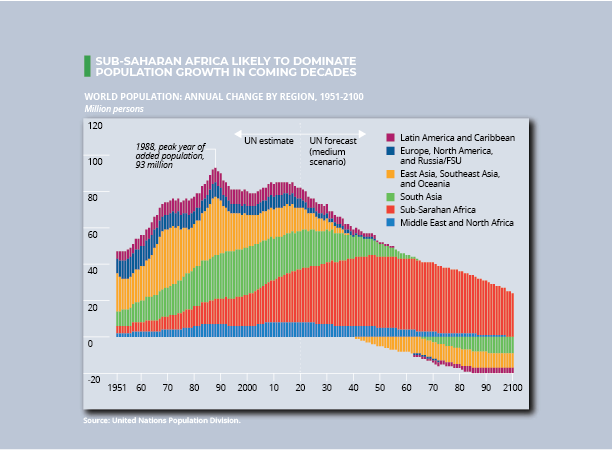
(SUB-SAHARAN AFRICA LIKELY TO DOMINATE POPULATION GROWTH IN COMING DECADES - Click image to enlarge)
Aging: An Opportunity and a Burden
The combination of fewer children per woman and people living longer will see the global population age rise from a median of about 31 years in 2020 to 35 in 2040. In middle-income countries, falling birthrates and older populations can facilitate human development improvements through an increased share of working-age adults in the population, more female participation in the workforce, and increased social stability associated with older cohorts. However, shifting age structures will challenge some governments, including some developing countries that are aging before reaching higher incomes, such as China and Eastern Europe, and poor countries with surging youth cohorts that will struggle to build sufficient infrastructure.
Older Populations. Rising old-age dependency ratios—the population age 65 and older relative to the working-age population—can weigh on growth even with adaptive strategies, such as automation and increased immigration. In many older countries, including a number of advanced economies, the cohort over 65 is likely to approach 25 percent of the total population by 2040, up from only 15 percent as recently as 2010. Japan and South Korea are likely to reach median ages of more than 53 in 2040, up from 48 and 44 respectively. Europe is not far behind with a projected average median age of 47, and Greece, Italy, and Spain are likely to age faster. These countries are likely to see further productivity slowdown in the coming decades because older workers usually show fewer productivity gains and a greater share of national income will be diverted to pensions and healthcare for seniors.
Working-Age Populations. Countries with large working-age cohorts and relatively few young and old dependents have the potential for higher household savings that can be directed to investment in human development. During the next 20 years, South Asia, Latin America, and the Middle East and North Africa will be in this window of high working-age populations relative to below-working-age and retired dependents. Sixty-eight percent of South Asia’s population will be of working age in 2040, up from an already elevated 66 percent in 2020. Latin America and the Middle East and North Africa probably will also benefit from peak working-age population proportions of above 65 percent in the coming 20 years. These opportunities for higher potential economic growth will occur only if those workers are adequately trained and can find jobs. South Asia’s ongoing challenges in job creation, technology adoption, and skills training suggest that it will have difficulties fully leveraging its potential labor force.
Youthful Populations. During the next two decades, most countries with large youth populations will be challenged to meet the basic needs of their populations, particularly in light of the social volatility often associated with youth bulges. In Sub-Saharan Africa, the median age is likely to rise only slightly to 22 by 2040, still well short of the median age threshold of 30 which is often associated with higher levels of human development. More than one-third of Sub-Saharan Africa’s population will be younger than 15 in 2040, compared with only 14 percent of the population in East Asia. Other populous countries that most likely will still be below the median age threshold in 2040 are Afghanistan, Egypt, and Pakistan.
URBANIZATION CHANGING DEVELOPMENT NEEDS
During the next 20 years, the success or failure of cities will shape opportunities and quality of life for a growing share of the world’s population. The urban population share is expected to rise from 56 percent in 2020 to nearly two-thirds by 2040, with nearly all of the growth in the developing world. Globally, large cities of more than 1 million residents have been growing at twice the rate of the overall population, and nearly 30 percent of the world’s population will live in such a large city by 2035, up from 20 percent in 2020, according to the United Nations’ (UN) projection. Some of the world’s least developed countries will have the world’s fastest growing urban populations. The number of urban residents in poor countries is likely to rise by 1 billion to more than 2.5 billion by 2040, according to UN Population Division projections. Sub-Saharan Africa and South Asia will contribute nearly half and one-third respectively of the increase in poor country urbanization.
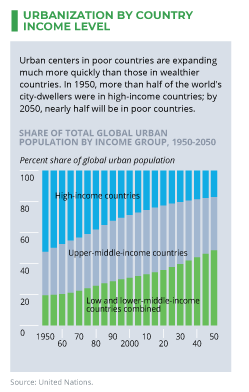
(URBANIZATION BY COUNTRY INCOME LEVEL - Click image to enlarge)
Urbanization has historically been a key driver of economic development as workers move into more productive jobs in cities and urban families benefit from better education and infrastructure. However, poorer countries that are rapidly urbanizing are likely to see a lower payoff from this virtuous cycle of development. Many developing country governments—even working with the private sector and nongovernmental organizations (NGOs)—will be challenged to fund the necessary urban transportation, public services, and education infrastructure. A 2017 World Bank study documented how urban areas in Sub-Saharan Africa often become stuck in a poverty trap in which insufficient worker skills and poor transportation networks have resulted in higher costs but lower incomes for workers. In addition, birthrates in Sub-Saharan Africa’s cities are higher than in other developing regions, potentially aggravating unemployment over time by increasing the labor supply in cities more quickly than jobs can be created.
These low- and lower-middle-income countries will also be at greater risk for food insecurity as they urbanize. They currently produce only one-third of the food per capita that upper-middle- and high-income countries produce, leaving many dependent on imports. Food distribution systems in these countries are under greater strain and are less resilient to shocks such as droughts or floods, and urban households lack access to subsistence farming opportunities.
Environmental events are likely to have a greater human impact on newly urbanizing regions where dense populations are located on coasts and in other vulnerable areas, but protective infrastructure—most importantly flood control and storm-hardy housing—has not kept pace. Booming cities of middle-income East, Southeast, and South Asia as well as the low-income urban areas of eastern and southern Africa are already exposed to the highest number of disasters per capita, based on statistics from the Emergency Events Database.
ASSOCIATED HUMAN DEVELOPMENT CHALLENGES
Many countries will struggle to build on or even sustain decades of significant improvements in education, health, and poverty reduction. During the past 20 years, at least 1.2 billion people were lifted out of poverty—that is their income surpassed $3.20 a day, which is equivalent to the average poverty line in low-income countries. In addition, nearly 1.5 billion reached the middle-class income level of at least $10 a day through a virtuous cycle of economic growth and human development in every region. Basic improvements in healthcare, education, and gender equality generated rising per capita incomes and, in turn, the fiscal capacity for households and governments to fund further improvements, especially in less developed countries.
However, sustained progress in some countries is likely to be more difficult during the coming two decades, particularly given the potential for slower and uneven economic growth. Many of the next levels of human development, including secondary and higher education and digital skills training, networked and efficient urban infrastructure, and improved opportunities for women and minority groups, require overcoming social impediments, improving political stability, and increasing government or private investment in public services. In much of the developing world, initial gains in human development focused on moving people out of subsistence farming into wage-earning jobs and making basic progress on health, education, and gender equality. In middle-income countries, these easier targets have already been achieved—infant mortality, for example, is minimal and almost everyone receives primary education—but complex new challenges, such as pollution and noncommunicable disease, are arising. Given the rapid expansion of middle-income households during the past two decades, governments may struggle to meet the needs and expectations of a more urbanized, connected, and vastly expanded global middle class.
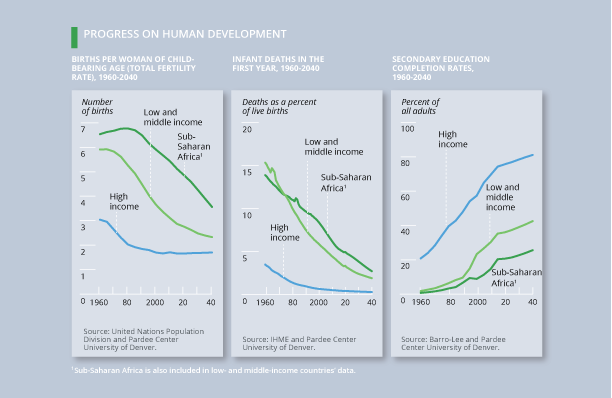
(PROGRESS ON HUMAN DEVELOPMENT - Click image to enlarge)
Progress for Women. The world has seen remarkable progress in women’s basic health and education in recent decades as well as an expansion of legal rights in many countries. Birthrates in most developing economies dropped to less than three children per woman of child-bearing age by 2020, and the age of first birth has risen, increasing the opportunities for education and work outside the home. Sub-Saharan Africa continues to be the greatest outlier on this metric: birthrates have decreased in recent years but still averaged 4.9 in 2020 and are likely to remain high. Maternal mortality has been reduced by more than one-third during the past 20 years, with South Asia accounting for most of the improvement. Most developing economies have rapidly reduced the gap in educational attainment for girls, although the average number of years of education for girls is still only 81 percent of the years for boys across Sub-Saharan Africa, a gap between that region and the rest of the developing world that is unlikely to close during the next two decades.
The patriarchal societies of the South Asia region and the Arab states exhibit the greatest gaps in overall gender equality in the home, at the workplace, and for medical care, and this shortfall is likely to continue for the next 20 years. Although women are the primary producers of food globally, they have limited or no rights to land ownership in many parts of the world. Subordination of women to men regardless of educational level is enshrined in family law in many parts of the Middle East, South Asia, and Sub-Saharan Africa. According to a 2020 UN review, women held only 25 percent of seats in national legislatures in 2020—although that is twice the level in 2000—held one quarter of corporate managerial positions, and accounted for less than one-tenth of chief executive officers of major companies.
Improved Childhood Survival and Welfare. In many countries the past two decades saw rapid advances in reducing malnutrition and infant mortality, which is mostly because of decreases in preventable communicable disease; there is little room for further dramatic improvements on this front. Progress will be especially slow in areas where conflict and crisis are on the rise. In the 1960s, 13 percent of infants died in the first year of life throughout the developing world; today it averages just over 3 percent in the developing world. The region with the greatest continuing challenges is Sub-Saharan Africa, where 5 percent of infants die within the first year, in large part because poverty and communicable disease rates remain high.
Expanding Access to Education. Educational attainment is an extremely powerful, slow-moving driver of human development, with expanding education contributing to lifetime expected earnings. Globally, the proportion of adults who have completed primary education reached 81 percent in 2020, reflecting a rapid increase across most regions and income groups since the 1960s. This level of attainment varies across developing countries, from up to 92 percent of all adults in developing countries in Latin America, East Asia and Pacific, and Europe down to only 60 percent in Sub-Saharan Africa.
Expanding access to secondary education, however, is likely to be harder for developing countries because of its relatively higher costs, higher dropout rates as some students choose work over education, and cultural factors such as early marriage that pull women away from formal education. Educating a majority of the workforce to the secondary school level has historically been a driver for countries to achieve upper-middle-income status. Currently, this majority threshold is reached in developing countries in Europe and Central Asia, East Asia and the Pacific, and Latin America, but only a quarter of the Sub-Saharan workforce has a secondary school education. Moreover, Sub-Saharan Africa is not likely to reach the threshold during the coming two decades because government, religious, and other private sector investment will struggle to keep up with population growth. This struggle will also dampen economic growth as workers, particularly those who choose early entry into the workforce over education, will lack the skills for higher paying jobs. South Asia is making better progress than Sub-Saharan Africa on this front and has the potential to reach the key development threshold for secondary education by around 2040.
RISING, SHIFTING GLOBAL MIDDLE CLASSES
Globally, the number of households falling into a broad definition of the middle class has soared in the past two decades, raising expectations for continued improvements. In 2020, approximately 36 percent of the global population was in the middle class with annual incomes of $4,000-$40,000, up 13 percentage points from 2000, judging from a World Bank database of income surveys. The largest growth in middle class populations during 2000-18 (the latest survey data available) by percentage of population occurred in Russia, Turkey, Thailand, Brazil, Iran, China, Mexico, and Vietnam, in descending order.
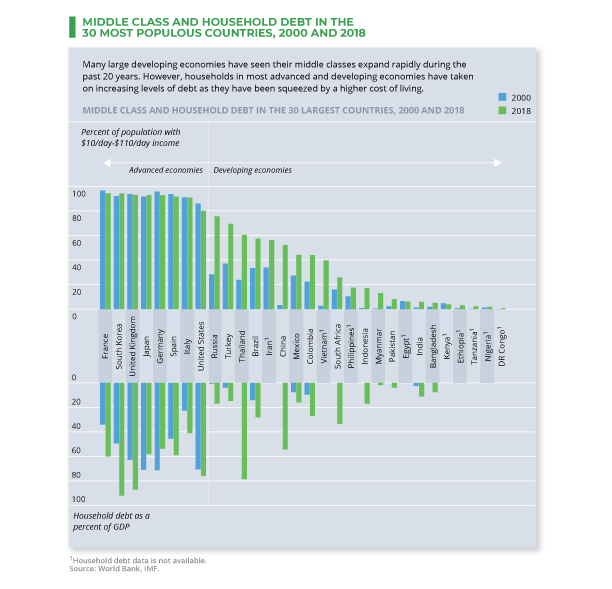
(THE MIDDLE CLASS SURGING IN SOME COUNTRIES, FINANCIALLY SQUEEZED IN MOST - Click image to enlarge)
During the next two decades, the middle class is unlikely to grow at a similar pace, and developing country middle-income cohorts could well perceive that their progress is slowing. Across many countries, the high per capita income growth of the past 20 years is unlikely to be repeated, as global productivity growth falls and the working-age population boom ends in most regions. Global models of household income suggest that, under a baseline scenario, the middle class share of the global population will largely remain stable during the next 20 years, although this outcome will be contingent on social and political dynamics.
East Asia, and to a lesser extent South Asia, appear better positioned to achieve further increases in per capita income relative to other regions, thereby reducing to some extent their income, education, and life expectancy gap with advanced economies. These regions benefit from effective education systems, generally stable social networks, and competent governance. On the other hand, some developing countries, including several in Latin America, are at high risk of falling into the middle-income trap in which inflation of take-home pay outpaces worker productivity, leading to a stagnation of economic growth. The problems in Latin America’s outlook stem in part from poor infrastructure and technology adoption and inadequate education systems.
In advanced economies, the middle class is contracting with many rising to higher incomes and a smaller portion dropping below the poverty line. Moreover, the middle class in many countries is strained by rising costs for housing, healthcare, and education. The percent of the population falling below the national poverty line in advanced economies has increased in 19 of 32 countries between 2007 and 2016, including in France, Germany, Italy, and Spain, while the majority of those that left the middle class across all advanced economies rose to higher income levels. This reflects the trend towards income polarization, in which the number of workers in low-income jobs and the number in high-income expands at the same time. Most high-skill workers probably will continue to benefit from workplace technology, while middle-skill workers doing repetitive tasks that can be automated will face declining wages and job losses. Even some workers in high paid professions may see their earnings challenged by artificial intelligence (AI) and machine learning. Household debt has already soared across advanced economies in recent years because of these income strains and higher costs for healthcare, housing, and education.
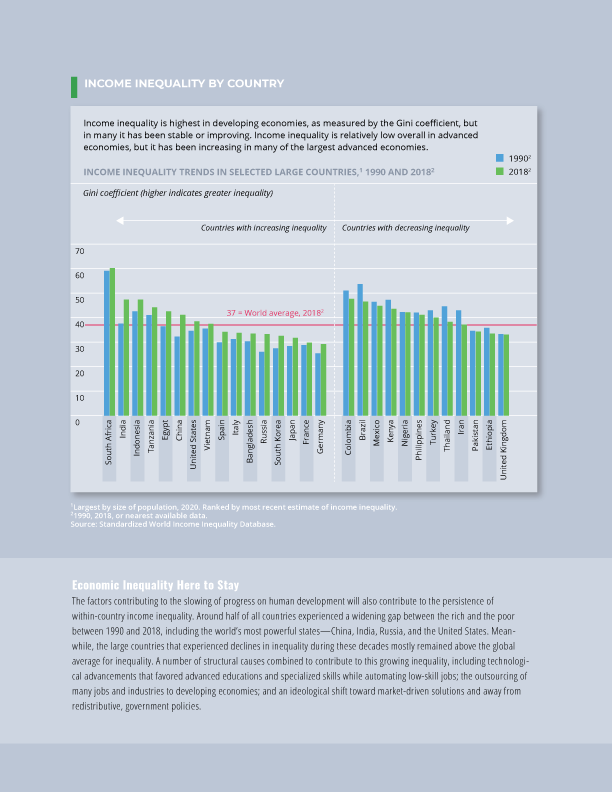
(INCOME INEQUALITY BY COUNTRY - Click image to enlarge)
MIGRATION: PEOPLE ON THE MOVE
Demographic trends and economic incentives will continue to drive large-scale migration during the next two decades. Although there is little certainty about the level of migration as government policies fluctuate, the push and pull factors for cross-border movements of people will endure globally—feeding debates in destination countries over migration and aggravating social divisions in some areas. The past 20 years saw a large increase in cross-border migration, not only in absolute numbers but also as a percent of the global population. More than 270 million persons in 2020 were living in a country to which they had migrated, 100 million more than in 2000, representing an increase of more than half a percent of the global population. Most migrants left their homes to pursue better economic prospects, but tens of millions were fleeing conflict, crime, religious and social repression, and natural disasters.
For the vast majority of migrants who are workers, migration flows clearly reflect wage differentials between countries—the flows are from smaller, middle-income economies to larger, high-income economies. Almost two-thirds of migrants in 2019 originated from middle-income economies, and more than half migrated to high-income countries for higher pay and to send remittances home. The fastest growth in emigration begins at around $4,000 per capita GDP, the point at which people have reached lower-middle-income and can afford to travel, and then begins to slow when per capita GDP reaches $10,000-$12,000 where people are nearing the World Bank’s definition of high income, making employment opportunities at home more attractive.
Looking forward, rapid population growth almost certainly will add to existing push factors in Sub-Saharan Africa, while many other developing countries are nearing the end of peak emigration. The population in the middle-income migration window of $4,000 to $10,000-$12,000 peaked around 2010 for several regions, including Latin America, Central Asia, and parts of Eastern Europe. East Asia, Southeast Asia, and South Asia are also nearing or past the strongest period for this income push factor, but the percent of the population in Sub-Saharan Africa in this income window will continue to rise during the next 20 years.
Greater need for workers in aging countries is a growing pull factor in European and Asian countries. European countries had the largest total number of cross-border immigrants at the end of 2019 at nearly 70 million, according to 2020 UN statistics. One-third came from Eastern Europe, which had a working-age population that was peaking just as advanced European economies were beginning to rapidly age. Aging European countries and Japan are expanding policies that provide visas for workers.
During the coming 20 years, people fleeing disasters and conflict will continue to contribute to migration flows. UN and NGO data show that domestic civil and political turmoil have pushed 80 million people out of their homes as of the end of 2019, of which about a third have migrated to other countries.
BROADER IMPLICATIONS AND DISRUPTIONS
These demographic and human development trends will put pressure on governments to increase public investment and manage immigration, lead to instability in some countries, in some ways contribute to a rising Asia, and add to the agenda of already strained international development institutions.
Setbacks for Women, Children, and Minorities. The current pandemic exemplifies the fragility of progress against poverty in some regions and the potential for regression for women, minority groups, and others lower in economic, political, and social stature. Although so far mortality in low-income countries, outside Latin America, has been lower than in the advanced economies, the economic impacts have been severe. Beyond overwhelmed healthcare systems and the negative impact on income for millions of the near poor, broader disruptions include lack of or limited education and the diversion of medical resources from other priorities, including vaccinations and maternal health.
Growing Pressure for Public Investment. Growing populations, especially middle classes in developing countries, are putting increased pressure on governments for the provision of public goods, such as affordable housing, education, healthcare, and infrastructure. Poorly governed urban areas, especially those with access to infrastructure such as international ports or airports, are also ideal habitats for organized crime syndicates.
Double-Edged Sword for Political Stability. Older populations tend to be less violent and ideologically extreme, thus reducing the risk of internal armed conflict. East Asia and Latin America will have a median age above 30, suggesting a potential for greater social stability. Such populations also have strong preferences for democracy; where authoritarian regimes remain, instability from so-called color revolutions is likely to persist. In addition, in countries with fast growing and youthful populations, the growing gap between the expectations of growing urban cohorts and their governments’ ability to provide for their education, healthcare, and job opportunities has the potential to increase political instability. In such countries, recruitment to radical extremist movements will be a major risk as well.
Increased Debate Over Migration. Immigrants can help developed economies mitigate the downsides of an aging population by improving economic productivity, providing services, and expanding the tax base. However, countervailing pressures such as strong cultural preferences for maintaining national identity and ethnic homogeneity could continue to fuel an antimigrant backlash in many developed countries and increasingly in some developing and middle-income countries with declining workforces, such as China. As a result, many are likely to choose technological innovation and automation and limit migration to highly skilled labor. Within and between countries, debates and division will continue over how much migration to allow and how to control flows.
Some Shifts Could Benefit a Rising East. Many developing countries in Asia will either gain potential advantages from demographic trends or are relatively well positioned to overcome demographic headwinds. As a result per capita incomes and human development levels probably will rise more in Asia than in any other region. Most Asian countries will continue to have large working-age populations, high secondary-level graduation rates, and, for many, substantial investments in health and infrastructure that bolster levels of well-being. The greatest variable is likely to be how China handles the demographic crunch it will see during the next two decades—the deep decline in fertility from its one-child policy has already halted the growth of its labor force and will saddle it with a doubling of its population over 65 during the next two decades to nearly 350 million, the largest by far of any country. Even if the Chinese workforce is able to rise closer to advanced-economy productivity levels through improved training and automation, China remains in danger of hitting a middle-income trap by the 2030s, which may challenge domestic stability.
Strained International Development Institutions. International institutions focused on human development will face a more complicated operating environment as demands for their coordination efforts grow. Any increase in humanitarian and refugee crises stemming from natural and human-created causes will divert international resources from efforts to make systemic improvements in poverty and disease. The likely failure of many countries to meet the UN’s 2030 Sustainable Development Goals will have the largest impact on middle-income societies where populations that have recently emerged out of poverty are demanding progress toward next levels of education, medical care, and environmental quality. Traditional providers of development assistance might not be able to keep up with needs. Shortfalls in multilateral development assistance could facilitate plans by China and other countries to gain advantage from financing critical urban infrastructure in developing countries.


